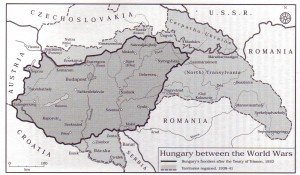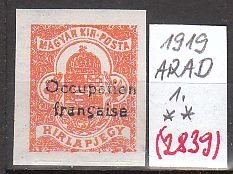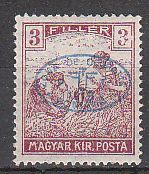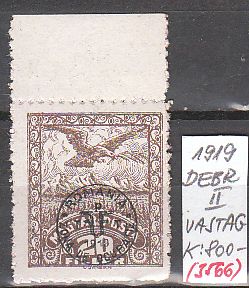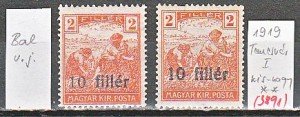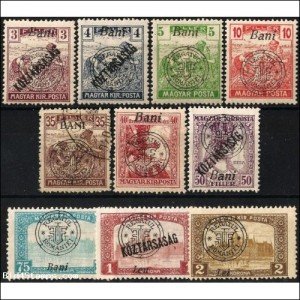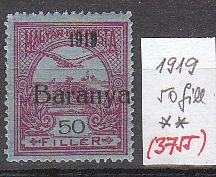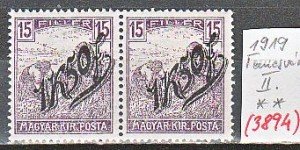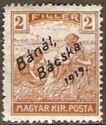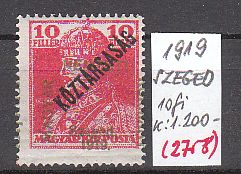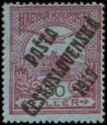*UPDATE:* Limited stock of Brainard’s catalog (Brainard Hungarian Occupation Stamp Catalog) is currently available in our online store.
One of the most complex and interesting eras of philatelic history in Europe is the post World War I period in Hungarian history. The years between 1918 and 1920 are an exciting period of complex events with shifting geographic borders culminating with the Treaty of Trianon in 1920. The philatelic issues of Hungary reflect this changing political and geographic time and are manifested in the overprinting of stamps.The overprinting is evidenced by the issuing of occupation stamps by the political authorities of the occupying countries of Romania and Serbia and the armies of France. Local issues were overprinted by municipal authorities and the Successor State issues were created and overprinted by Czechoslovakia, Yugoslavia, Romania, Austria and Fiume (Italy).
Almost two-thirds of Hungary’s population became minorities in the countries that took over Hungary’s land as a result of the terms of the infamous Treaty of Trianon which ceded 70% of Hungary’s territory to the occupiers. Many people emigrated back to Hungary but most stayed within the borders of their new countries and steadfastly retained their Hungarian heritage and culture. Trianon represents for all Hungarians the most devastating tragedy in their history. Large portions of the country including land inhabited by ethnic Magyars were given to the successor states of Romania (Transylvania), Yugoslavia (Croatia and Slovenia) and Czechoslovakia (northern Hungary). The only Hungarian port city of Fiume went to Italy, Austria received parts of western Hungary (Burgenland) and even Poland received a share.
During the occupation period the current stamps of Hungary were overprinted by the authorities identifying their territory. These stamps were used to fulfill territorial postal needs and became extremely popular with stamp collectors of the time and sold out rapidly. Limited printings and speculation caused the values of the stamps to skyrocket. Demand soon overwhelmed supply which caused the rampant forgeries of stamps to occur.
During this same time period, there were also local stamps that were issued by municipal authorities throughout Hungary. An additional category of stamps were issued by the successor states which were the countries that annexed parts of Hungary .
Occupation stamps: There were 10 series of occupation stamps issued which document this chapter in the history of Hungary. The categories and their occupiers as listed in the Scott catalog are:
1N – France – Arad region occupied by French military forces
2N – Romania – first issue of Debrecen occupied by Romanian military
3N – Romania – second issue of Debrecen occupied by Romanian military
4N – Romania – Temesvar region, which followed the Serbian occupation
5N – Romania – first Transylvania issued for town of Kolozsvar
6N – Romania – second Transylvania issued for town of Nagyvarad
7N – Serbia – first Baranya occupied by Serb military
8N – Serbia – second Baranya occupied by Serb military
9N – Serbia – Temesvar, this was the first occupation of Temesvar
10N – Serbia – Banat, Bacska, this was actually a locally initiated issue between the Serbian and Romanian occupations of Temesvar.
The Temesvar territory was located in the south of Hungary between Yugoslavia and Romania. It was originally occupied by Serbia (9N), then governed by local forces, while still under control of Serbia (10N) and then occupied by Romania (4N). The Serbians took much of the money and machinery in Temesvar with them upon their retreat so the Romanians paid their forces with occupation stamps.
Szeged: was the location of the Hungarian National Government which opposed the central Soviet government in Budapest. This opposition government issued overprinted stamps with the inscription Hungarian National Government (Magyar Nemzeti Kormany).
Successor states: The successor states took over Hungarian territories and overprinted Hungarian stamps in the local post offices as their first issues. The Czechoslovakian stamps had the additional function of raising money for war relief as a surcharge to the postal rate. That’s why they are considered semi-postal stamps.
Czechoslovakia – Semi-Postal issues with overprints on Hungarian stamps
Yugoslavia – 2L issues for Croatia and Slovenia overprinted on Hungarian stamps.
Fiume – Inter-Allied control commission overprinted Hungarian stamps for use in Fiume (now Rijeka).
Local Issues: There are many local issues that will be a future topic for the blog. The difference between local issues and occupation issues is that local issues were those that were overprinted by local or municipal authorities for use in that municipality. An occupation issue is that which is overprinted by a foreign or occupying government for use in the territory that was occupied. Some examples of municipalities that are included in the category of locals issues are: Zombor, Ada, Nagyszeben, Kluj, Pancsova, Perlak, Baranya III, Skalica, Lajtabansag (Western Hungary) and several others. Lajtabansag issued several beautiful series of stamps between 1918 to 1921. These are illustrated in both the Michel and the Scott Classic catalogs.
Forgeries: Extensive forgeries abound for the occupation stamps. Several reference books have been published documenting the forgeries and the genuine issues. One of the best of these is “Catalog of Hungarian Occupation Issues” published by Chris Brainard and used as a reference for this article. Chris illustrates examples of forgeries and also indicates characteristics of geniune overprints. One of the ways to distinguish genuine stamps from forgeries is by expertization marks placed on the back by numerous expertizers. This however is not a foolproof method because some of the forgers “expertized” their forgeries by putting their own marks on the back. The most famous of these was “PAPE” who was one of the most extensive forgers. If you see that mark on the back of the stamp you can be relatively sure that it’s a forgery. He actually started by expertizing genuine stamps and then realized that there was much more money to be made in creating the forgeries and then “expertizing” them. A very useful site that lists the expertizers and their marks is at the url – http://www.filatelia.fi/experts/areash.html
Reference Material: There are several excellent references available to further research this time period in philatelic history. The “Magyar Posta- es Illetekbelyeg Katalogus” is published annually by the Hungarian Post in Hungarian and over the last few years has included a much more comprehensive listing than the previous editions for both the occupation and local issues. Chris Brainard’s work mentioned above is a valuable cataloging of both types of stamps and includes some not found in the “Magyar” catalog. I would also like to reference a monograph written by Csaba Kohalmi of the Society for Hungarian Philately in March, 2000, which in my view is one of the most comprehensive works on categorizing occupations and locals issues of Hungary. I sincerely thank Csaba for letting me use his work as a reference.
Stamps of the Occupation period are illustrated below:
1N is the French Allied forces Occupation of the Arad region in Southeastern Hungary
2N is the first Debrecen occupation in southern Hungary
3N is the second Debrecen occupation in southern Hungary. It is the only Occupation issue that has custom designed stamps. All other series were overprinted on Hungarian stamps of 1913-1914
4N is the Romanian occupation of Temesvar, which followed the Serbian occupation
6N is the 2nd Transylvanian occupation by Romania
7N is the Serbian Occupation of the southern area of Baranya.
8N is the second series of stamps for the Serbian Occupation of the southern area of Baranya.
9N is the Serbian occupation of Temesvar, which was jointly occupied by Romania.
10N is the Serbian Occupation of the Banat and Bacsa regions, which eventually were ceded to Yugoslavia
